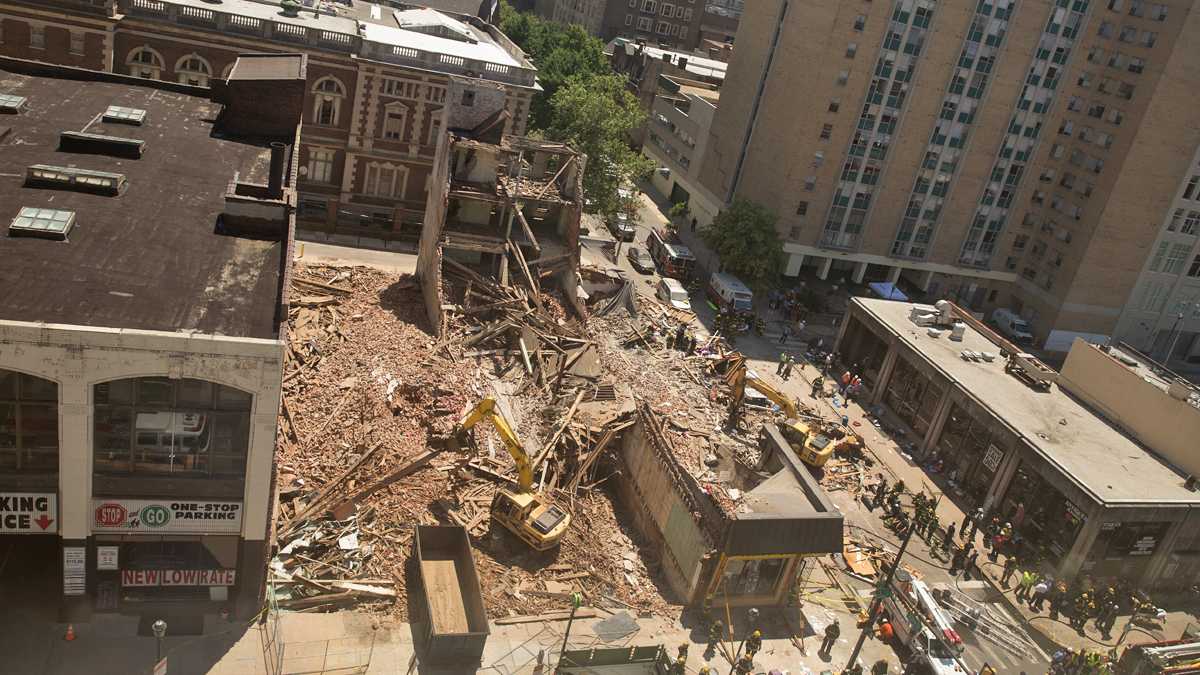Jury selection begins this week in Philly building collapse civil trial

(Lindsay Lazarski/WHYY)
In January, a Philadelphia judge incarcerated general contractor Griffin Campbell and excavator operator Sean Benschop for their roles in a deadly building collapse that shocked the city in 2013. On Tuesday, Campbell and Benschop will be defendants again as jury selection starts in the civil trial tied to the tragic Center City episode that killed six and injured 13 more.
They won’t be alone this time.
Nearly 20 individual defendants are listed in the case, including building owner Richard Basciano, who hasn’t spoken publicly about the collapse since it happened, only deposed in private. Basciano’s name is all over the nearly 200-page civil complaint filed in September 2014.
Plaintiffs argue that the wealthy octogenarian knew the four-story “Hoagie City” building was being demolished in an “incompetent, reckless, and outrageous manner, but still did nothing about it. That negligence, they say, resulted in an unsupported wall crushing an adjoining and busy Salvation Army thrift store the morning of June 5, 2013.
The complaint lodges similar claims against STB Investment Corporation, Basciano’s company, site architect Plato Marinakos, Campbell, Benschop, and the Salvation Army (which operated the thrift store that was crushed with several people inside).
Marinakos, who was granted immunity from criminal charges for testifying before a grand jury and at Campbell’s 2015 trial, is expected to take the stand during what should be a weeks-long trial.
Jury selection alone could take days as both sides try to find people who can approach the high profile, highly visible case with an open mind.
“I’m not saying that someone who has heard about that case can’t have an open mind, but preconceptions can be hard to dislodge. Ideally, you’d like to teach your jurors everything about the case from your perspective and your adversary would do the same,” said veteran personal injury attorney Harry Kane.
Basciano, who was never charged criminally, is also on the 64-person witness list.
The city is not a defendant, but city officials — current and former — are expected to take the stand too, most notably Scott Mulderig, emergency services director with the Department of Licenses and Inspections and former deputy mayor for economic development Alan Greenberger.
Family members of those killed, as well as victims are also expected to testify. That group includes Mariya Plekan, who lost both legs after being trapped in the rubble for more than 12 hours.
A gag order was recently put in place, barring attorneys, or anyone part of the case, from speaking to the media.
In October 2015, Robert Mongeluzzi, the case’s lead attorney, said in an interview that the “criminal trial just dealt with Griffin Campbell’s responsibility. The responsibility of the owner, the Salvation Army and others, who contributed to this catastrophe, remains for the civil trial. And [the plaintiffs] look forward to proceeding with the civil trial so that everyone is held accountable.”
Damages could be in the millions, though litigation may stretch over years.
The wall fell at 10:42 a.m. on June 5, 2013 as an excavator was chipping away at the property. Chaos ensued as police, firefighters, paramedics and reporters rushed to the scene of what is now considered one of the city’s deadliest days.
The story garnered national media attention.
Benschop, the excavator operator, turned himself into police a few days after the collapse. Griffin Campbell did the same that November.
Both faced life in prison after they were charged with multiple counts of third-degree murder. The decision followed a grand jury presentment recommending those charges, in addition to involuntary manslaughter and aggravated assault.
The third-degree murder charges were later dropped against Benschop as part of a plea deal that called on him to testify at his former boss’ trial.
Campbell was offered the same deal as Benschop, but rejected it.
At trial, prosecutors argued that Campbell purposely cut corners because he was more concerned with making a profit from salvaging the building’s guts than safely taking down the property.
Similar to the civil complaint, they said the building should have been taken down by hand, top to bottom, not with the help of heavy machinery.
Marinakos, the architect, hired Campbell after he bid $112,000 to demolish a handful of buildings along the 2100 and 2200 blocks of Market Street, according to testimony. It was, by far, the lowest bid.
Before taking the job, Campbell had only demolished a three-story row home. He didn’t have a general contractor’s license until six months before the collapse. He said he took the job because
Marinakos told him he would guide him through the job.
Former employees, including Benschop, testified that they tried to warn their boss about the dangers of the unsupported that later collapsed onto the Salvation Army thrift store.
On the stand, Campbell said those conversations never happened.
“I didn’t kill anybody,” Campbell told jurors. “I got up and went to work.”
In October 2015, the panel found Campbell guilty of involuntary manslaughter, aggravated assault and related offenses.
Bill Hobson, Campbell’s lawyer, has called his client a scapegoat paying for the mistakes made by people above him.
Campbell was sentenced to 15-30 years behind bars. Benschop got half that, 7.5-15 years.
WHYY is your source for fact-based, in-depth journalism and information. As a nonprofit organization, we rely on financial support from readers like you. Please give today.


